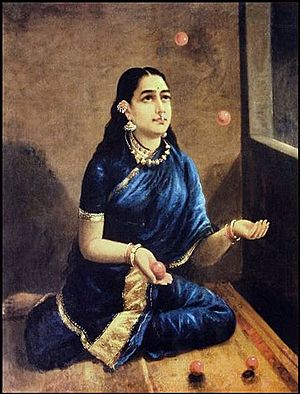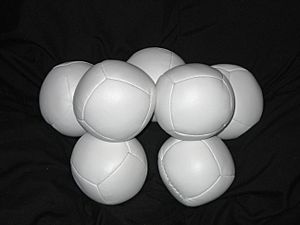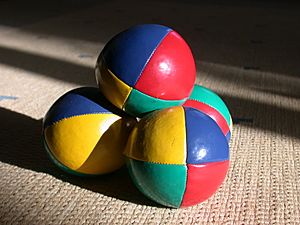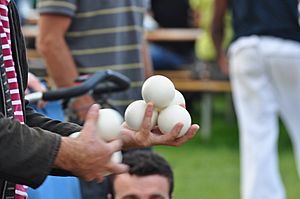Juggling ball facts for kids

Juggling balls are special objects used by people who juggle. They are usually round and come in sets of three or more. Jugglers use them by themselves or with other props like clubs or rings. A juggling ball is simply any round object made for juggling.
Contents
Types of Juggling Balls
There are many different kinds of juggling balls. Each type has special features that make it good for different kinds of juggling.
Beanbags
Beanbags are the most common type of juggling ball. They have an outer shell, often made of vinyl or a soft fabric. Inside, they are filled with things like millet, sand, or plastic pellets. This filling gives them weight and shape.
Jugglers like beanbags because they don't bounce or roll away when dropped. This makes them great for practicing. They are also easy to catch and usually not too expensive. Beanbags come in many colors and sizes. Smaller, lighter beanbags are sometimes used by jugglers who want to juggle many balls at once.
Stage Balls
Stage balls are often used in juggling shows. They have a shiny, hard outer shell, usually made of plastic or rubber. These balls are hollow, which means they can be made larger than beanbags but still be light enough to juggle.
Stage balls keep their shape and color well, making them easy for an audience to see. However, they roll away easily when dropped. Because of this, jugglers usually don't use them for daily practice. Famous jugglers like Sergej Ignatov have used very large stage balls to create a dramatic effect in their performances.
DX and Russian Balls
DX balls are a mix of beanbags and stage balls. They have a hard outer shell like stage balls. But they are partly filled with millet seeds, similar to beanbags. This design helps them fly smoothly in the air. It also means they don't roll away when dropped.
Russian balls are another unique type. They have a thin shell and are mostly filled with sand or salt. This makes them "dead drop" like beanbags, meaning they don't roll. They also have a low center of mass, which can make them easier to catch with parts of the body other than hands. Many jugglers make Russian balls at home because the materials are cheap.
Bouncing Balls
Bouncing balls are made for a special type of juggling called bounce juggling. These balls are designed to bounce back up high, usually 75-90% of the height they were dropped from. They are made from silicone or a special rubber.
Silicone balls are a popular type of bouncing ball. They look clean and shiny like stage balls. They are also easy to grip and have a very consistent bounce. Silicone balls are also easier to clean than stage balls. However, they are much more expensive than other types of juggling balls. Because of their cost, they are mostly used by professional performers or serious hobbyists.
How Juggling Balls Are Used
Juggling balls are often the first props that beginners learn with. They are simpler to handle than other juggling props like clubs. You can even use everyday balls like tennis balls to start learning. Most new jugglers spend a lot of time learning to juggle three balls. Some jugglers choose to focus only on balls to become experts with them.
For more experienced jugglers, balls are used to perform many different patterns. These include basic patterns like the cascade and fountain. Jugglers can also create complex patterns, like throwing balls around their body or catching them without looking. Many advanced jugglers can juggle seven or more balls at once. This is because balls are generally the easiest prop to juggle in large numbers.
However, some juggling tricks are not as good with balls. For example, tricks that involve spinning or twirling, often done with clubs or rings, don't look the same with balls. This is because a ball looks the same from any angle. Also, when jugglers pass props to each other, clubs are often preferred because their spin looks cool, and they are larger and easier to catch from far away.
Juggling balls can also be used for contact juggling. In this style, the juggler rolls the balls over their body without throwing them into the air. For contact juggling, jugglers usually use stage balls or balls made specifically for this style.
Juggling Records
Jugglers are always trying to set new records! The record for juggling the most balls in the air (where each ball is thrown and caught at least twice) is eleven balls. This was achieved by Alex Barron in 2012, with 25 catches.
For bounce juggling, the record for the most balls juggled is ten. A famous juggler named Enrico Rastelli was also known to juggle ten balls in the 1920s.
The record for "flashing" the most balls (where each ball is thrown and caught just once) is fourteen. Alex Barron set this record on April 19, 2017.




